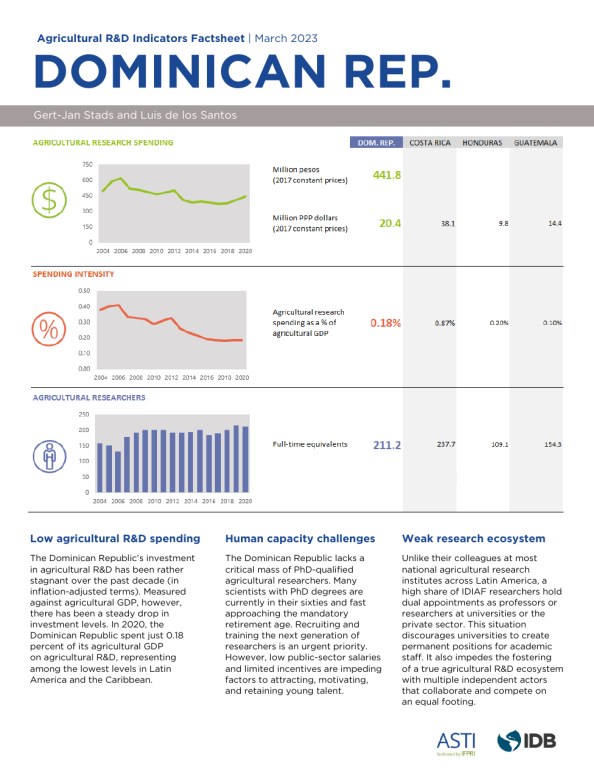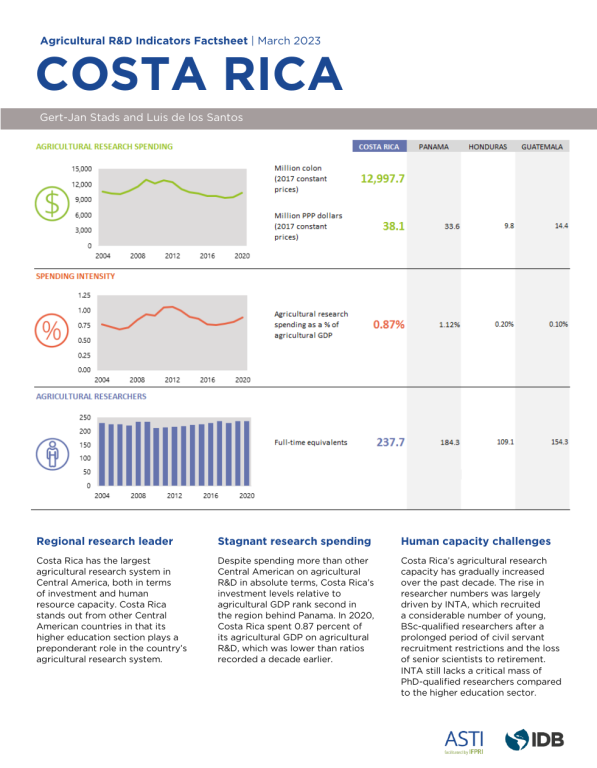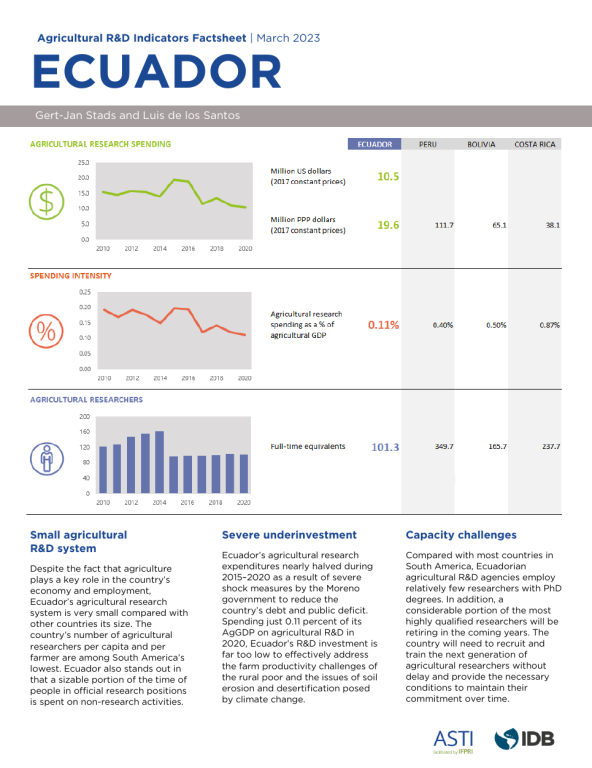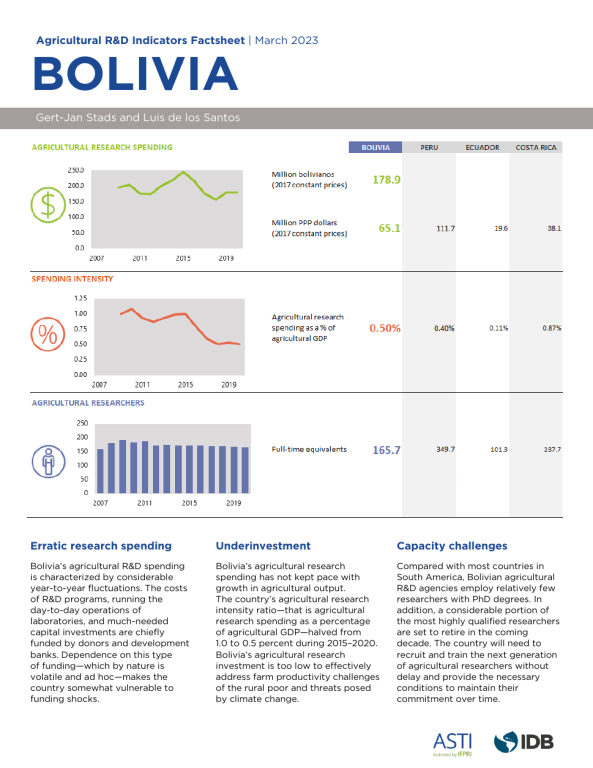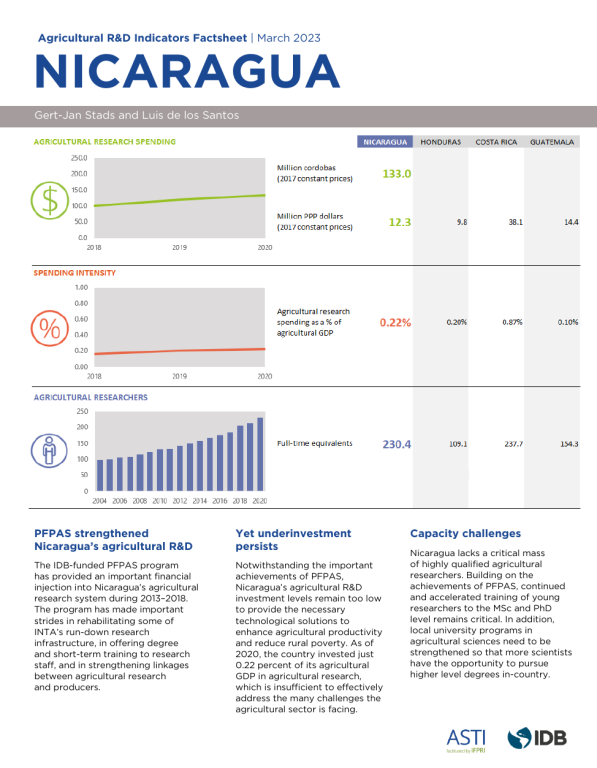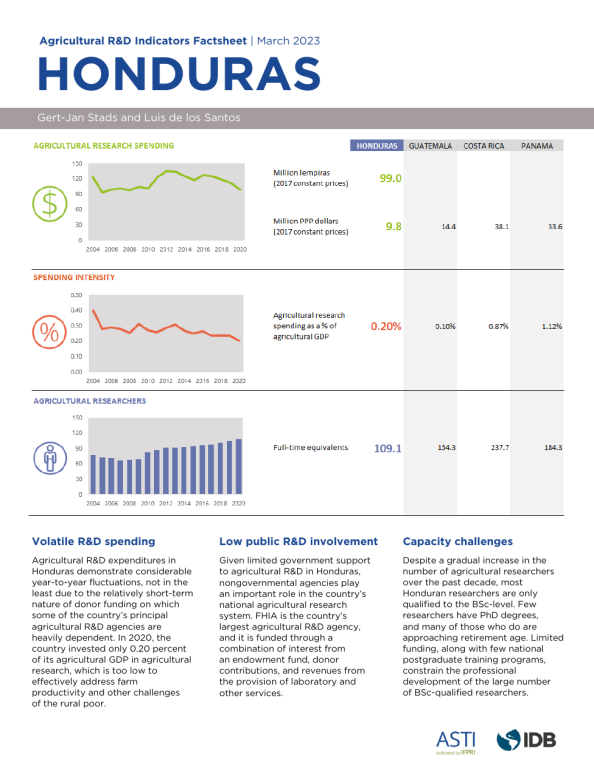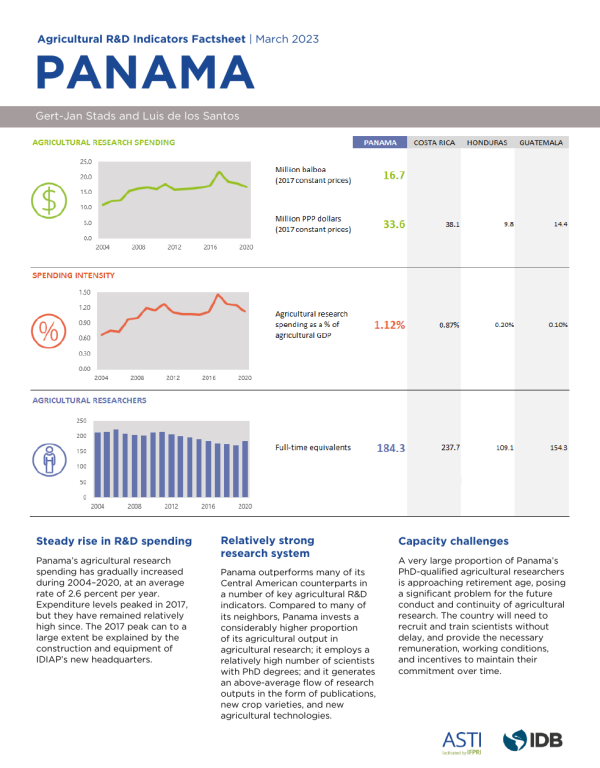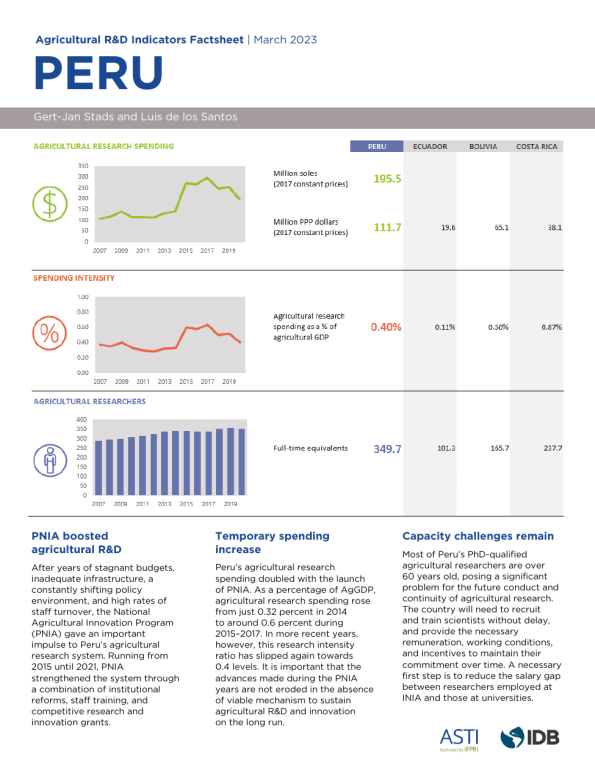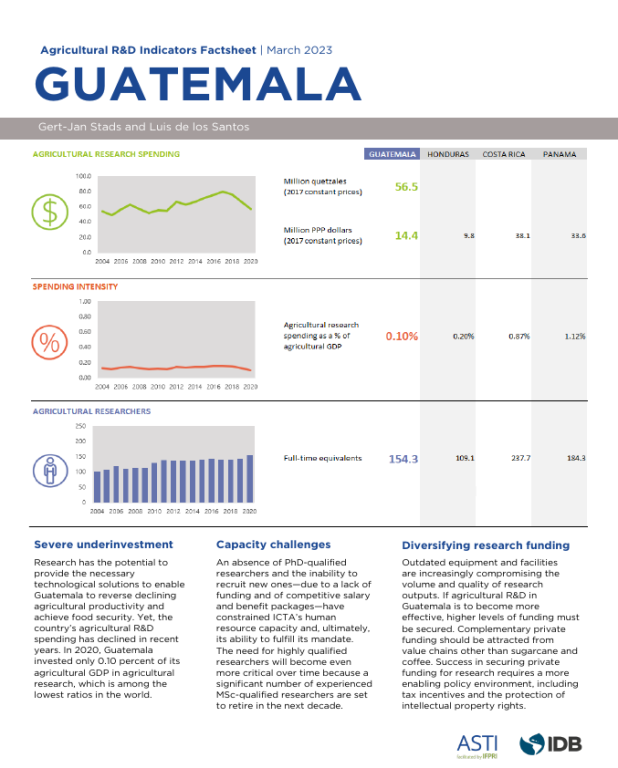Bolivia: Hoja informativa 2023
Gasto errático en investigación
El gasto en I&D agropecuaria de Bolivia se caracteriza por fluctuaciones considerables de un año a otro. Los costos de los programas de I&D, las operaciones diarias y las inversiones de capital que tanto se necesitan son financiados principalmente por donantes y bancos de desarrollo. La dependencia de este tipo de financiamiento, que por naturaleza es volátil y ad hoc, hace que el país sea vulnerable a los choques de financiamiento.
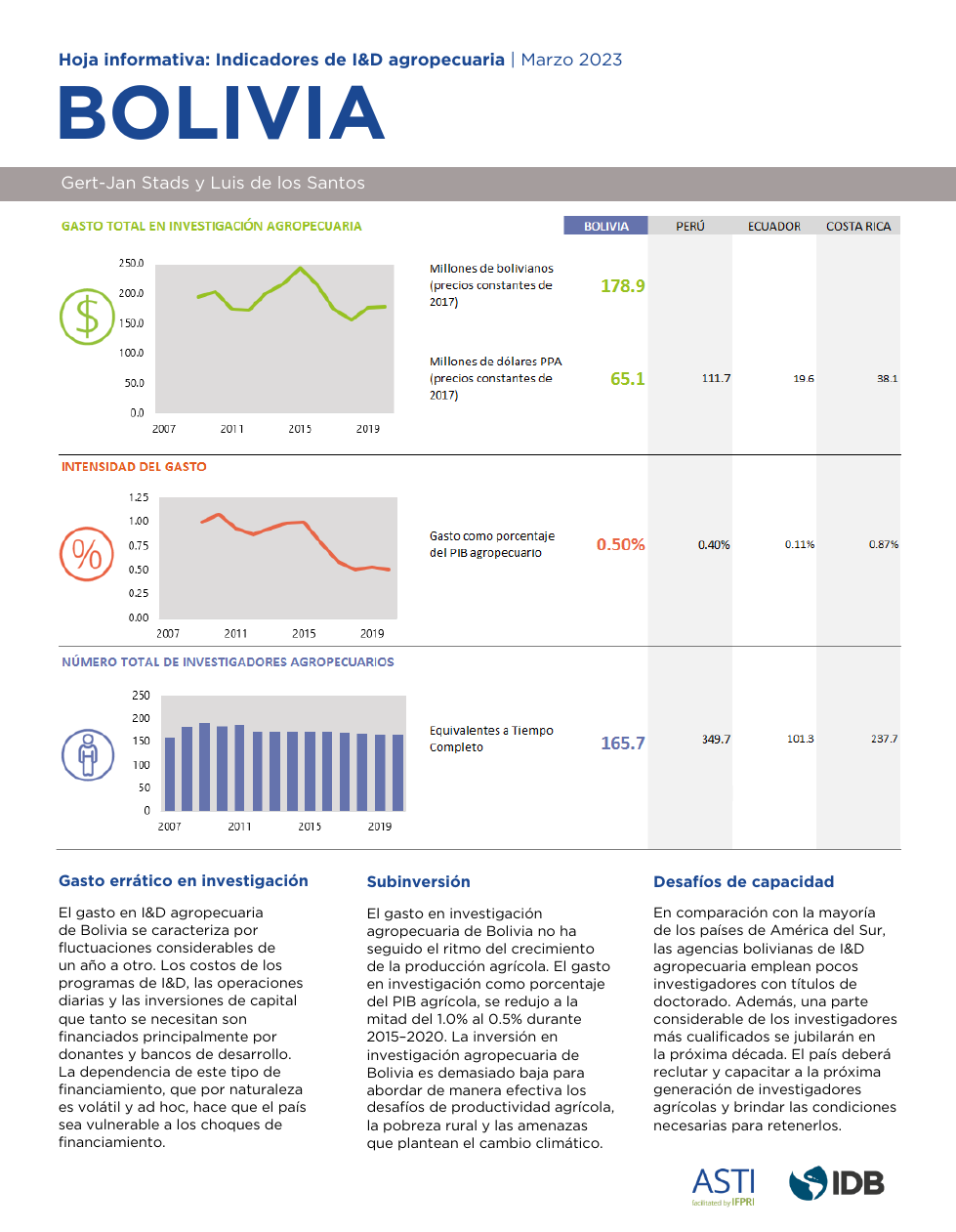
Authors:
Gert-Jan Stads and Luis de los Santos
Year:
2023
Publisher
ASTI, The Inter-American Development Bank (IDB), International Food Policy Research Institute (IFPRI).
Back to:
Low agricultural R&D spending
The Dominican Republic’s investment in agricultural R&D has been rather stagnant over the past decade (in inflation-adjusted terms). Measured against agricultural GDP, however, there has been a steady drop in investment levels. In 2020, the Dominican Republic spent just 0.18 percent of its agricultural GDP on agricultural R&D, representing among the lowest levels in Latin America and the Caribbean.
Authors:
Gert-Jan Stads and Luis de los Santos
Year:
2023
Publisher
ASTI, The Inter-American Development Bank (IDB), International Food Policy Research Institute (IFPRI).
Back to:
Regional research leader
Costa Rica has the largest agricultural research system in Central America, both in terms of investment and human resource capacity. Costa Rica stands out from other Central American countries in that its higher education section plays a preponderant role in the country’s agricultural research system.
Authors:
Gert-Jan Stads and Luis de los Santos
Year:
2023
Publisher
ASTI, The Inter-American Development Bank (IDB), International Food Policy Research Institute (IFPRI).
Back to:
Small agricultural R&D system
Despite the fact that agriculture plays a key role in the country’s economy and employment, Ecuador’s agricultural research system is very small compared with other countries its size. The country’s number of agricultural researchers per capita and per farmer are among South America’s lowest. Ecuador also stands out in that a sizable portion of the time of people in official research positions is spent on non-research activities.
Authors:
Gert-Jan Stads and Luis de los Santos
Year:
2023
Publisher
ASTI, The Inter-American Development Bank (IDB), International Food Policy Research Institute (IFPRI).
Back to:
Erratic research spending
Bolivia’s agricultural R&D spending is characterized by considerable year-to-year fluctuations. The costs of R&D programs, running the day-to-day operations of laboratories, and much-needed capital investments are chiefly funded by donors and development banks. Dependence on this type of funding—which by nature is volatile and ad hoc—makes the country somewhat vulnerable to funding shocks.
Authors:
Gert-Jan Stads and Luis de los Santos
Year:
2023
Publisher
ASTI, The Inter-American Development Bank (IDB), International Food Policy Research Institute (IFPRI).
Back to:
PFPAS strengthened Nicaragua’s agricultural R&D
The IDB-funded PFPAS program has provided an important financial injection into Nicaragua’s agricultural research system during 2013–2018. The program has made important strides in rehabilitating some of INTA’s run-down research infrastructure, in offering degree and short-term training to research staff, and in strengthening linkages between agricultural research and producers.
Authors:
Gert-Jan Stads and Luis de los Santos
Year:
2023
Publisher
ASTI, The Inter-American Development Bank (IDB), International Food Policy Research Institute (IFPRI).
Back to:
Volatile R&D spending
Agricultural R&D expenditures in Honduras demonstrate considerable year-to-year fluctuations, not in the least due to the relatively short-term nature of donor funding on which some of the country’s principal agricultural R&D agencies are heavily dependent. In 2020, the country invested only 0.20 percent of its agricultural GDP in agricultural research, which is too low to effectively address farm productivity and other challenges of the rural poor.
Authors:
Gert-Jan Stads and Luis de los Santos
Year:
2023
Publisher
ASTI, The Inter-American Development Bank (IDB), International Food Policy Research Institute (IFPRI).
Back to:
Steady rise in R&D spending
Panama’s agricultural research spending has gradually increased during 2004–2020, at an average rate of 2.6 percent per year. Expenditure levels peaked in 2017, but they have remained relatively high since. The 2017 peak can to a large extent be explained by the construction and equipment of IDIAP’s new headquarters.
Authors:
Gert-Jan Stads and Luis de los Santos
Year:
2023
Publisher
ASTI, The Inter-American Development Bank (IDB), International Food Policy Research Institute (IFPRI).
Back to:
PNIA boosted agricultural R&D
After years of stagnant budgets, inadequate infrastructure, a constantly shifting policy environment, and high rates of staff turnover, the National Agricultural Innovation Program (PNIA) gave an important impulse to Peru’s agricultural research system. Running from 2015 until 2021, PNIA strengthened the system through a combination of institutional reforms, staff training, and competitive research and innovation grants.
Authors:
Gert-Jan Stads and Luis de los Santos
Year:
2023
Publisher
ASTI, The Inter-American Development Bank (IDB), International Food Policy Research Institute (IFPRI).
Back to:
Severe underinvestment
Research has the potential to provide the necessary technological solutions to enable Guatemala to reverse declining agricultural productivity and achieve food security. Yet, the country’s agricultural R&D spending has declined in recent years. In 2020, Guatemala invested only 0.10 percent of its agricultural GDP in agricultural research, which is among the lowest ratios in the world.

